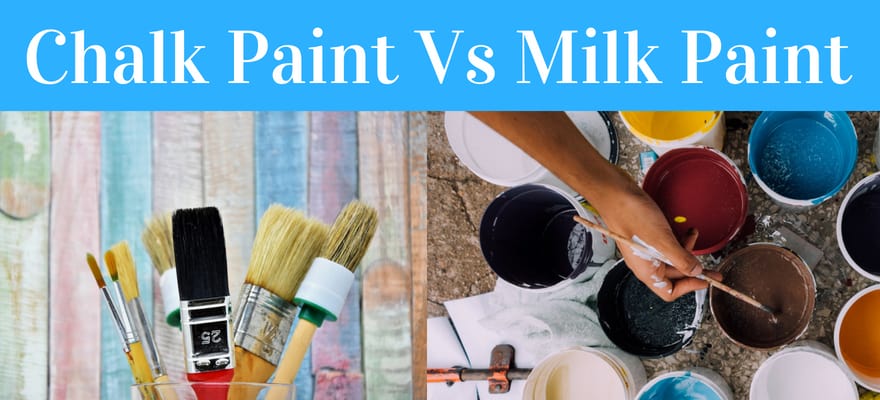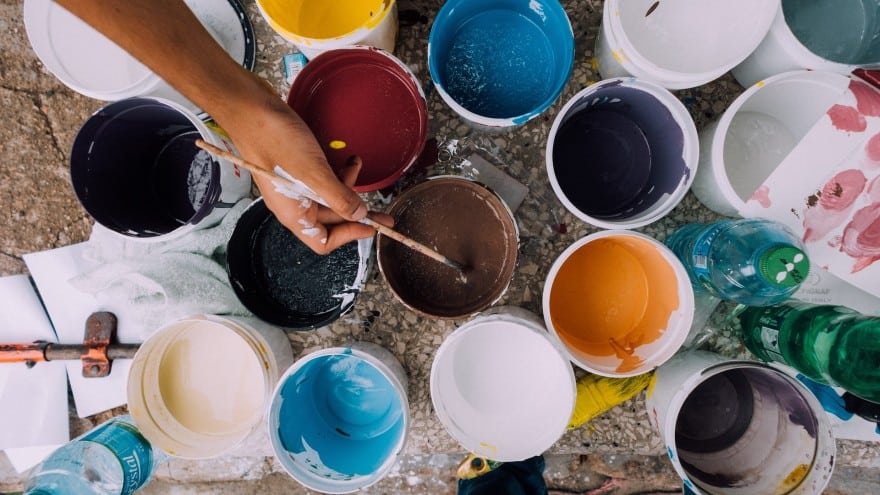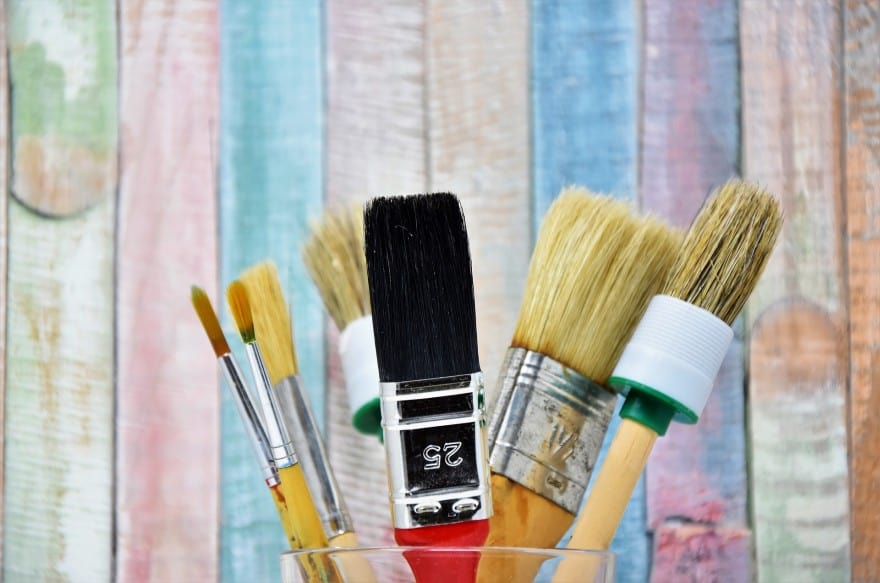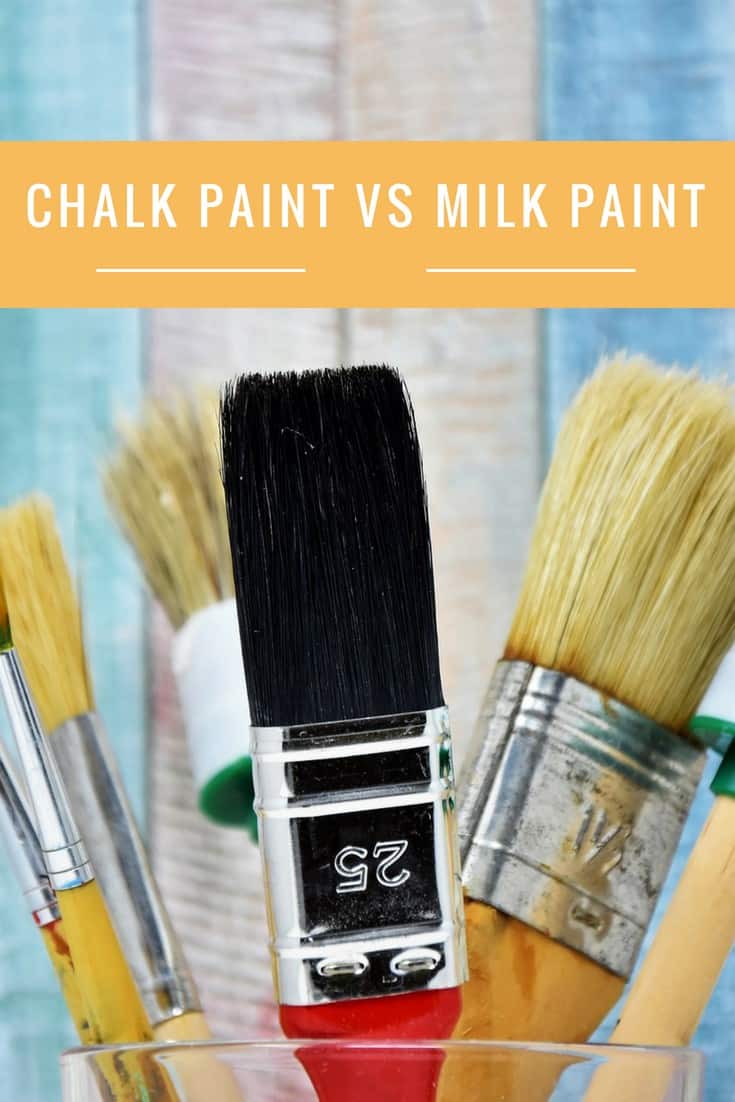There is no better and more affordable way of freshening up your furniture and overall home décor than with a new coat of paint.

Plus, painting isn’t intolerably difficult and doesn’t need specialized training – all you need is a little patience, practice, and the right paint.
When looking for a DIY paint, two popular options include chalk paint and milk paint. In most cases, the two paints perform similar functions, and this makes it hard to choose the best between them.
To properly use the paints, therefore, you have to understand their properties and performance. For an educated decision between the two options, here’s what to know about chalk paint vs milk paint.
What is Chalk Paint?
Chalk paint is a thick paint that derives its name from its characteristic chalk-like undertones which give surfaces an old looking and distressed look. Usually the ingredients of this type of paint include calcium carbonate, chalk pigments, and talc but you can find DIY recipes with other ingredients as well.
This type was initially created by Annie Sloan but other brands have appeared in the market as well.
The paint is known to have a fast-gripping action due to its thickness. When applied, chalk paint looks similar to acrylic coat. The paint comes ready to use, so you are not expected to do any mixing. For this reason, chalk paint is costlier than milk paint. There are over 30 decorative colors of chalk paint, and all are known to dry faster than other paints.
What is Milk Paint?
Milk paint derives its name from its main ingredient, milk casein. In addition to the protein, the paint contains also limestone as another main base (and some other ingredients as well). It is one of the oldest paints on earth.
Milk paint comes in powder form usually, and you are expected to add water before you can use it. In most cases, the final paint is lighter in consistency.
Considering its form and method of preparation, the paint is considerably cheaper than chalk paint. Since its coat is thin, you may be required to make several layers if you are targeting a thick finish. The beautiful thing though is that milk paint works on a range of surfaces. You can get the paint in over 20 decorative color options.

What Can You Paint with Chalk or Milk Paint?
The two paints are known to stick on an array of home surfaces. Accordingly, you can paint using any of the two paints on wood, drywall, concrete, glass, metal, and furniture surfaces. Painting furniture indeed is the most popular usage of both Chalk and Milk paints.
However, milk paint is better suited for old pieces of furniture, such as an antique dresser or a farmhouse kitchen cabinetry. You can also use it on other surfaces but you’ll need a bottom coat for the paint to hold.
On the other hand, chalk paint is flexible for most DIY duties. You can use it on outdated furniture, new furniture, fabrics, and metal accents. The finish, however, may not be a smooth one and also it usually requires extra wax on top of it for long-lasting effect.

Chalk Paint Characteristics
Chalk paint gives your surface a matte finish. In other words, the paint does not reveal the brush strokes. You can apply chalk paint with a roller, or brush.
Pros
- Easy to apply since it comes ready to use.
- Gives a strong adhesion on furniture surfaces.
- It doesn’t reveal the brush strokes.
- You don’t need a lot of layers since the paint gives you a thick finish.
- Doesn’t need a primer.
- The paint has a longer shelf-life as it stands weather elements.
- You can mix different colors to achieve a customized finish.
- Results in a great distressed finish after waxing.
Cons
- Some brands are unfriendly to the environment due to toxic ingredients.
- Requires a top coat (wax or varnish) to hold up well.
- Costlier than milk paint.
- The paint cracks over time unless you apply a top wax or varnish coat.
Milk Paint Characteristics
Milk paint is naturally known to distress (give you an antique look) over time. This is why it’s suited for painting antique and farmhouse-like surfaces. You can apply the paint using a spray gun, roller, or brush.
Pros
- You can paint different layers to achieve a unique custom finish.
- Do not require sanding prior to application.
- It’s eco-friendly as the ingredients are non-toxic and odor-free.
- The finish is always clear after waxing.
- You can dispose it anywhere since its non-toxic.
Cons
- The paint goes bad over time when exposed to moisture and air.
- The powdered form of the paint cracks over time unless you apply a bonding agent.
- The brush strokes may show since the coats are thinner.
Chalk Paint vs. Milk Paint for Kitchen Cabinets
As aforementioned, the two paints are similar in performance, and for this reason, most DIY enthusiasts tend to confuse their applications.
Generally, the two paints share a number of traits. For instance, both paints are fast-drying, attractive, and easy to apply.
Moreover, they are well suited for painting your kitchen cabinets if you want. In some cases, you can mix various colors of each type to produce customized kitchen cabinet colors and textures.
Nonetheless, the two paints differ mostly in the coats they produce. Milk paint normally gives a thinner coat while chalk paint gives a thicker one.
If you are planning to apply the first coat, maybe on newly-made kitchen cabinets, chalk paint is the most suited. Even so, you’ll need another top coat of wax or varnish for the paint to hold lest it cracks over time. Chalk paints come ready to use, so you can easily apply it. Considering that chalk paint has a firm grip on wood surfaces, you don’t need a bonding agent like in the case of milk paint.
On the other hand, if you are planning to paint a cabinetry surface that already has a primary coat, you can use milk paint. The paint is lighter, sticks, and is not prone to cracking (if you add a bonding agent in the mixture before you start painting).
For a lasting finish, when using any of the paints, you should seal the painted surfaces with wax or varnish as soon as the coat dries. This will also make the finish to shine and appear attractive.
Final Verdict
The suitability of the two paints generally depends on your DIY application. If you are looking for a paint to use on your antique furniture and other wooden surfaces, milk paint will do since it distresses easily. Besides, the paint is cheaper in price, and you can do the mixing by yourself.
However, if you are scouting for a paint that works on any surface, chalk paint is the best bet. Though costly, the paint will give you a thick coat, and will not reveal the brush strokes or the texture of the painted surface.

Related Posts
- 15 Stores Like Home Depot for Your Home Projects (Great Alternatives)
- Types of Portable Toolboxes To Consider Buying for your DIY Projects
- 30 DIY Ugly Sweater Ideas for Christmas and Parties
- 7 Steps To An Affordable DIY Above-Ground Pool
- How Much Weight Can Drywall Hold? Let’s Find Out Here
- How to Install Brick Molding Around Windows and Doors (DIY)
Leave a Reply